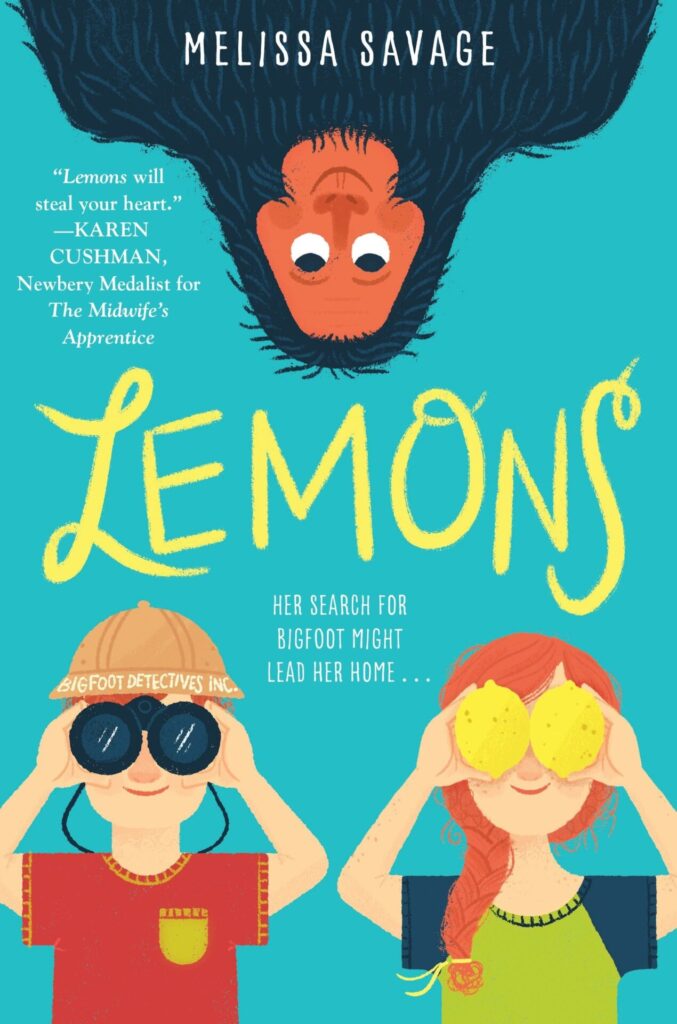
Why I Picked It Up: This summer, we went through a LOT of audio books. I have my go-to authors, but we’d pretty much exhausted those, so I was browsing some middle-grade novel blogs and Lemons jumped out, probably because of the upside-down Bigfoot on the front. My son likes mythical creatures, and I was curious as to how lemons would play into a Bigfoot story.
Why I Finished It: To find out if Bigfoot exists, of course! (Kidding…sort of…) From the beginning, we were all captivated by this story – myself, my 2nd grader, and my PreKinder kiddo. There is a timeless quality to Savage’s writing – which sounds like a cliché, but it really wasn’t until about half way through that I realized that this wasn’t taking place in the present day. The people, the relationships, the feelings are all so genuine and relatable, you could almost put them in any time period.
Lemons takes place in a small town in California in a time where kids spent the summer riding around on their bikes having adventures and phones were still attached to the wall with cords. Without internet and cell phones, things were simpler, freer, and for Lemonade Liberty Witt (Lem, for short) and Tobin Sky, this gives them plenty of room to figure things out. For Lem, there’s the grief of losing her mother and having to leave her life in the city to live with an estranged grandfather. The disappearance of Tobin’s father still haunts him, though he doesn’t like to talk about it. And, of course, they have a Bigfoot to find!
This is a story of finding your place, learning about feelings, and navigating relationships. As I was reading and processing the story, I was struck by the depth and introspective nature of Savage’s writing. I definitely wasn’t expecting that from such a bright, whimsical cover and title. It all made sense, however, when I read the author’s bio on the back flap – Savage is child and family therapist with a desire to write “purposeful, issue-driven books” and she has certainly done that.
Who I Would Give It To: I’d recommend it for upper elementary through middle school. There are many different storylines and themes one could focus on, so I feel like it has a pretty broad appeal to all sorts of readers in that age-range. Lemons would also be a great tool to help students identify feelings and thoughts around loss and grief.
Integration Ideas
Themes
Dealing with Grief/Loss
When you’re experiencing great loss, it often comes with really big, unfamiliar feelings. Sometimes, it helps to just be able to explain how you feel, and that’s usually a really hard thing to do, especially for a young person experiencing loss. Most central to the story is Lemonade’s loss of her mother. Savage uses several vivid metaphors to give voice to Lem’s feelings – a volcano (p 43, 53, 85, 191), drowning in quicksand (87, 177, 216, 268) and carrying something heavy (76, 129). There are two lovely scenes (127-130, 200-201) where Mrs. Dickerson, Bigfoot Detectives, Inc.’s best customer, helps Lemonade process through her grief while giving her insight into the loss of the others in her life. “Life is the definition of loss. But it makes us grow, and it makes us stronger” (p 129).
However, while Lemons is written from Lemonade’s point of view, Savage explores a broad range of grief through a variety of characters who have lost loved ones. Tobin is dealing with the grief and confusion of losing his father, who was drafted to Vietnam and didn’t come home. Tobin’s mom has lost her husband. Charlie is dealing with the grief of losing his daughter (Lem’s mom) twice, and with the grief of his wife’s death.
Relationships
There are many parallels between the legendary, elusive Bigfoot and other characters in the story, especially in the ways they relate to people. On page 16, Lem asks Tobin why he hasn’t found a Bigfoot yet, and why they’re hiding from people. Tobin replies, “‘Cause people can hurt you.” Tobin has certainly experienced how people can hurt others with the other kids in town, as he is the butt of many practical jokes and doesn’t seem to fit in with the kids at school. Later on, he says, “Just ’cause you don’t understand them doesn’t make them beasts or monsters!” (63). “You see, they need to hide in this world […] Because they’re different. And people choose not to understand those that are different. And can become…cruel. […]” (223).
Lemonade has several relationships to explore. She must navigate a new relationship with a grandfather she didn’t know about. At one point, Lem has the opportunity to choose to go back to San Francisco to rejoin her former life and friends, and that comes to a head as she’s developing her friendship with Tobin (p 171). Both Tobin and Lemonade begin to find friendship with the other kids in town, which helps Lemonade feel like she belongs (p 133).
Names/Character Change
Names are an important part of identity, of letting the world know who a person is. Lemonade undergoes significant change in this story, as one would expect after the death of a loved one. Her name, and the story behind why her mother gave it to her, is a part of the framework for that change. In a passage beginning on page 41, Lem is trying to figure out who she is, where she fits, and she compares this to puzzle pieces. She explains why her mom named her Lemonade – “[…] I can take any lemons that life gives me and make lemonade” (42). Tobin remarks that she doesn’t seem to be very good at it anymore, and Charlie remarks that “She’s had some really big lemons to deal with lately” (42). The chapter concludes with Lemonade wondering if she’ll ever be herself again.
Towards the end (spoiler alert), Lem visits Charlie in the hospital and reads his full name out loud and realizes that she doesn’t know how to make fix her situation (205 -206). In the next chapter, Tobin matter-of-factly reminds her that she still knows how to make lemonade “[…] it’s still in there somewhere” (209). A dream where Lem and her mom are together in an ice cream shop helps her process and bring closure to the past as she looks forward to her future (p 276-278).
Here are a few other places where full names make an appearance:
- p 49 – Lemonade whispers her mother’s name “out loud every day so the universe remembers how important it is, and that it still matters to someone.”
- p 51 – Seeing her name in writing on her name badge makes Lem feel important.
- p 120 – Tobin tells Lem his dad’s full name.

Research
Reading Lemons, made me want to do ALL THE RESEARCH about Bigfoot! There is so much legend and lore surrounding this creature, and there is also a great deal of scientific research as well. It’s a great opportunity to practice determining credible resources as you explore the plethora of internet resources.
Start with some background information: https://en.wikipedia.org/wiki/Patterson%E2%80%93Gimlin_film
Then practice your best “fake news”/research skills by asking questions. What else do you want to know? About this film? About the places? About the science behind different species of primates? Here are a few links for help in determining credibility:
- https://docs.google.com/document/d/1wpDm3zSQn8xgfsM4k53MKXopO9YshbFp7og9LZmDN6Y/edit
- https://www.commonsense.org/education/digital-citizenship/lesson/finding-credible-news
- https://newslit.org/updates/evaluating-unnamed-sources-in-news-reports/
- https://www.learningforjustice.org/classroom-resources/lessons/evaluating-reliable-sources
There are a few significant “Bigfoot” references that might be of interest to research:
- Charlie’s Bigfoot Museum
- Dermal ridges and metatarsal breaks
- Primates/Hominids
- Willow Creek: Willow Creek, CA
- https://willowcreekchamber.com/
- Check out the original Patterson and Gimiln film: https://www.youtube.com/watch?v=OBTUQI60yqQ
- Bluff Creek: https://maps.roadtrippers.com/us/ca/nature/bluff-creek
Also, check out Savage’s pictures of her own Bigfoot excursion: https://www.melissadsavage.com/lemons
Social Studies – Time and Place
While the story was very relatable, there were a few key things that tipped us off that Lemons wasn’t taking place in present day. Here are a few that would be interesting to look into. Have pictures available to provide some context for students that might never have seen a phone plugged into a wall, let alone an answering machine!

- p 10 – “On the front page is an article about the Vietnam War finally coming to an end.”
- p 11 – movie cameras, with film
- p 19 – tape recorder/answering machine
- p 34 – Polaroid camera
- p 64 – Fotomat
- p 109 – Sear’s Catalog
- p 203 – nurse’s uniform (all white)






Leave a Reply